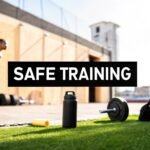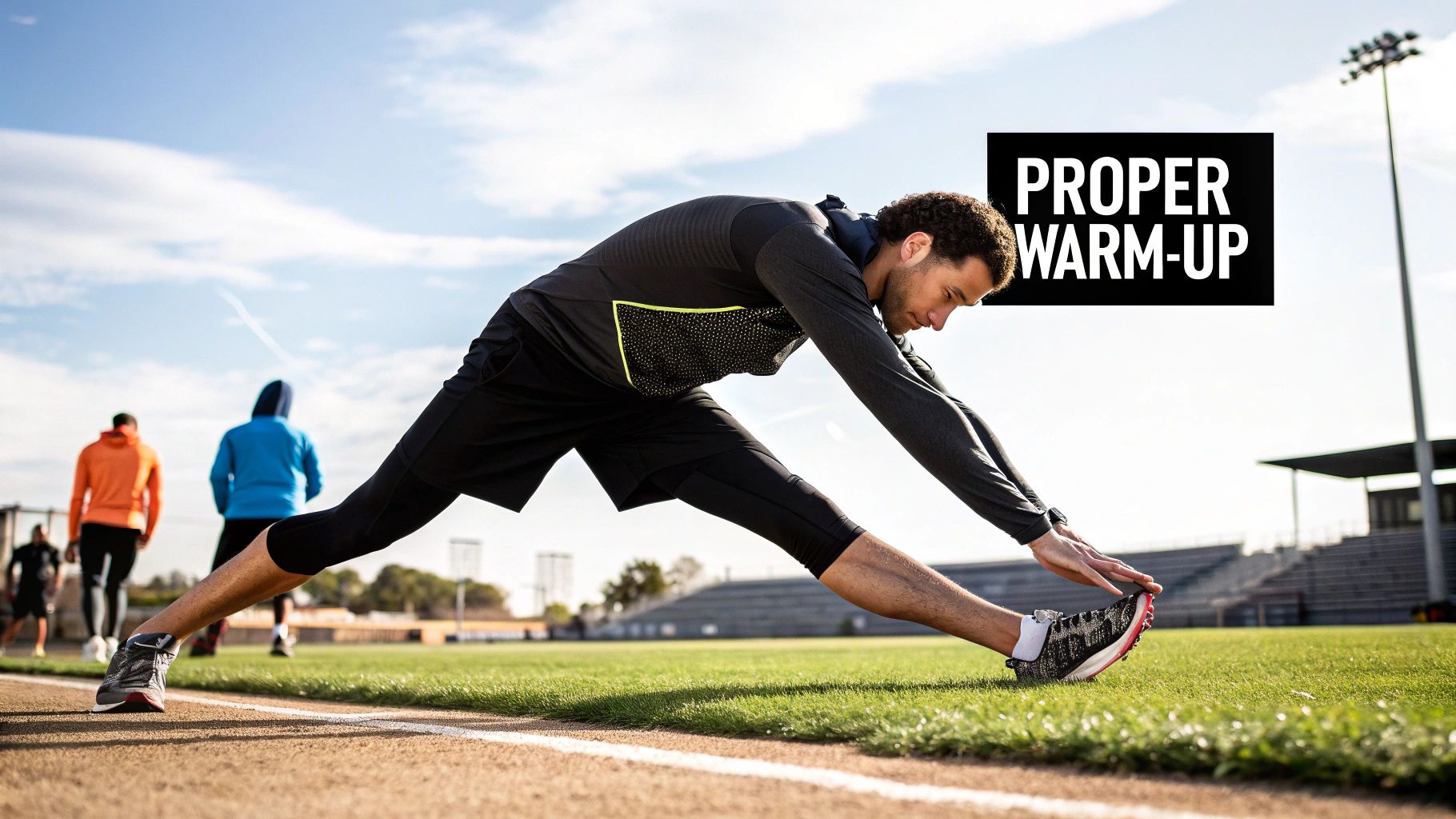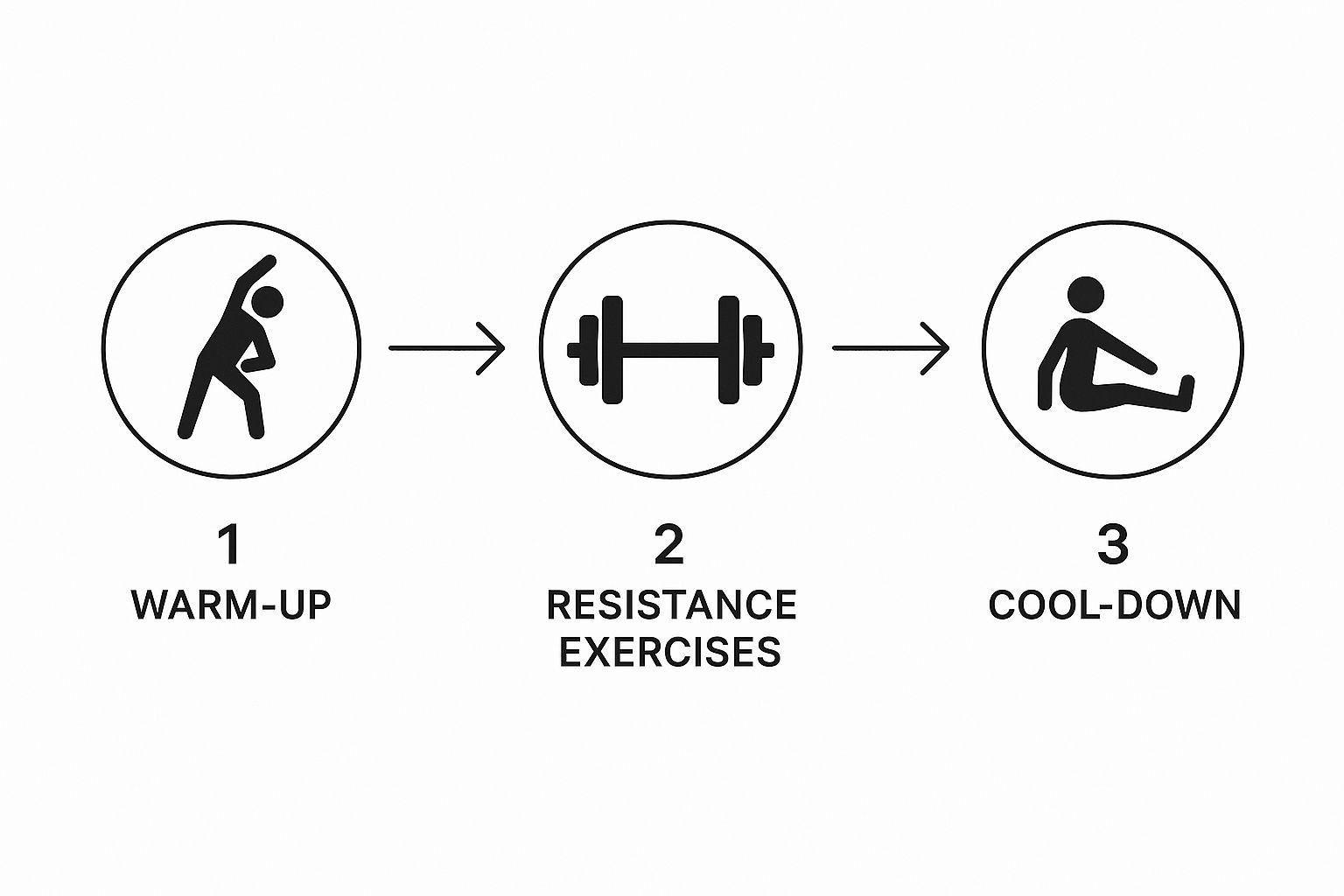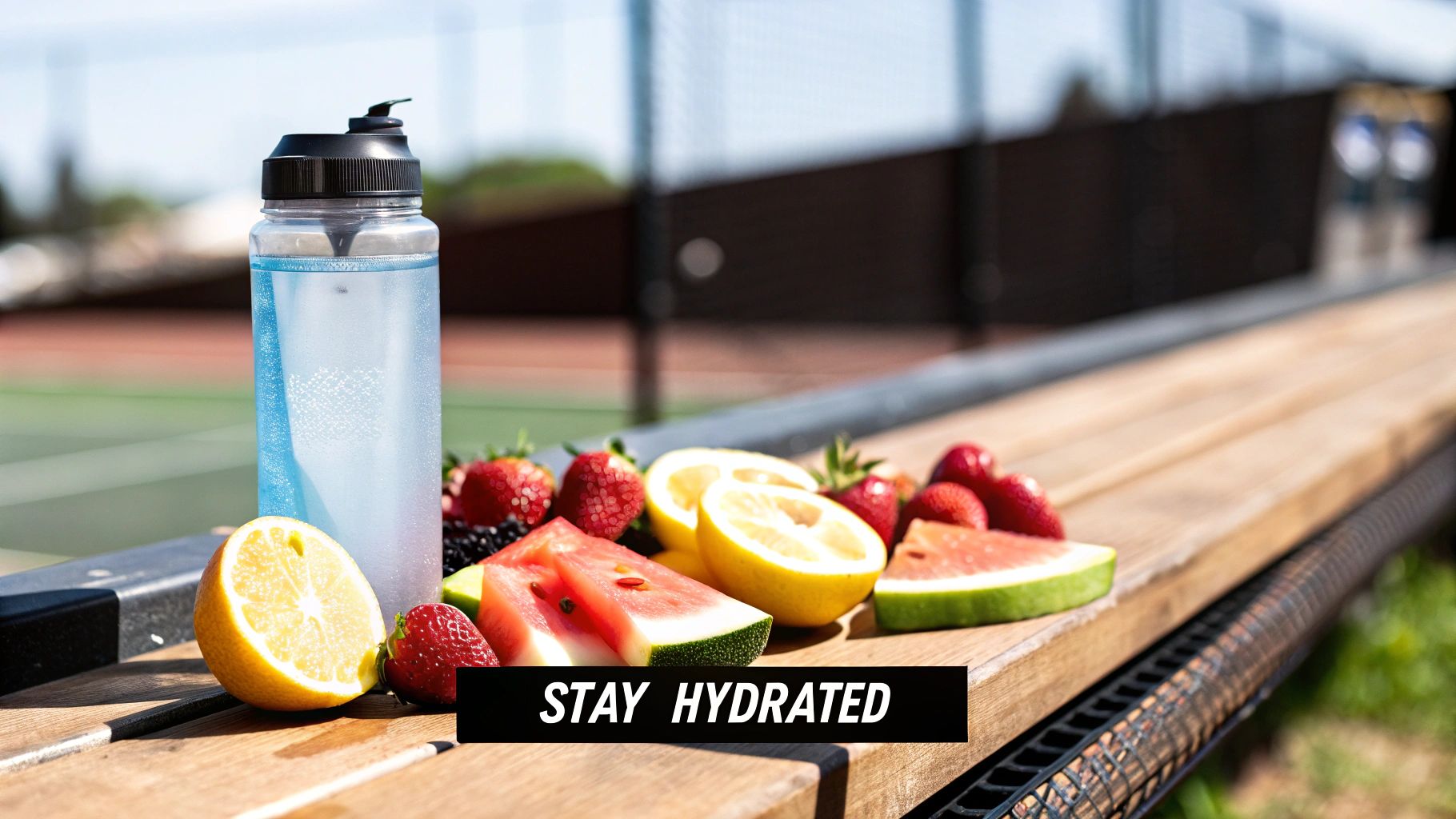How to Avoid Sports Injuries: Expert Tips for Safe Training

When it comes to sports, the best defense against injury is a good offense. This isn't about being aggressive on the field; it's about being proactive with your body before you even start playing. A truly effective strategy is a blend of smart preparation, disciplined technique, and intentional recovery. It’s about building a body that’s not just strong, but genuinely resilient to the unique demands of your sport.
Building a Proactive Injury Prevention Mindset

The real secret to staying in the game isn't avoiding activity—it's preparing your body for it with purpose. I’ve seen countless athletes fall into the reactive trap, only addressing a problem once the pain starts. This section is all about shifting that mindset. We'll focus on how to make physical preparation an ongoing process that not only keeps you healthy but can actually elevate your performance.
Think of this proactive approach as the most valuable piece of equipment you own. It’s not a checklist you tick off before the season starts; it’s a continuous cycle of smart choices that you make every single day.
Adopting the Athlete's Perspective
Elite athletes live by a simple truth: availability is their best ability. You can't perform if you're sidelined. They don't just train for power and speed; they train for resilience. Injury prevention is woven into the very fabric of their routine, from their morning meal to their post-session cooldown.
This perspective is especially critical when your activity level changes. After a break—whether it's an off-season or just a busy couple of weeks—your body is far more vulnerable. Just look at the data. After a historic dip in sports injuries during 2020, emergency departments saw a 20% surge in 2021 as people jumped back into their activities. This starkly illustrates the danger of returning to play without rebuilding your foundation. You can dig deeper into how sports participation impacts injuries with data from the National Safety Council's injury facts.
The goal is to make your body so well-prepared that it can handle the stress of your sport without breaking down. It's about building physiological armor through consistent, intelligent effort.
Core Pillars of a Resilient Body
A proactive mindset isn't just a vague idea; it's built on a few core pillars that support each other. If you neglect one, you create a weak link in the chain that leaves you exposed to injury.
To keep things clear, here’s a quick-reference table that breaks down these essential components.
Core Pillars of Injury Prevention at a Glance
| Pillar | Key Focus | Primary Benefit |
|---|---|---|
| Dynamic Preparation | Actively warming up the exact muscles and movement patterns used in your sport, moving beyond outdated static stretches. | Increases blood flow, improves mobility, and primes the nervous system for specific actions, reducing the risk of strains. |
| Technical Mastery | Concentrating on proper form to distribute force correctly across joints and muscles, avoiding overload on any single area. | Enhances efficiency, improves performance, and significantly cuts down on chronic and acute injuries caused by poor mechanics. |
| Strategic Recovery | Treating rest, sleep, and nutrition as active parts of training that repair tissue, reduce inflammation, and refuel the body. | Accelerates muscle repair, restores energy systems, and prevents the cumulative fatigue that often leads to breakdown. |
By mastering these pillars, you create a powerful, synergistic effect. Each element strengthens the others, turning what might seem like a chore into your greatest performance advantage. You’re not just avoiding injury—you’re building a more efficient, robust, and capable body.
Mastering Your Warm-Up and Cool-Down Routine
When people ask how to avoid sports injuries, the first thing that usually comes to mind is the old advice to "stretch before you play." While the intention is good, we know a lot more now. A truly effective routine is about much more than a few quick, static stretches. It's about thoughtfully preparing your body for the demands ahead and then guiding it back to a state of rest.
Think of the warm-up and cool-down as the bookends of your workout. They're your first line of defense against injury. Skipping them is like starting a car in freezing weather and immediately flooring it—you’re just asking for a breakdown.
The Power of a Dynamic Warm-Up
Forget those old-school gym class stretches where you'd hold a hamstring stretch for 30 seconds. Before you start any activity, your body craves movement, not static holds. A dynamic warm-up is all about actively moving your muscles and joints through their full range of motion. This is a game-changer for injury prevention.
This active approach gets your core temperature up, pushes blood flow to the muscles you're about to use, and wakes up your nervous system. You're not just passively pulling on a cold muscle; you're actively priming it for the real-world movements of your sport.
- For Soccer Players: Instead of a simple quad stretch, try leg swings (forward and side-to-side) and walking lunges with a torso twist. These movements get your hips, hamstrings, and core ready for the explosive kicking and sharp cuts you'll be doing on the field.
- For Swimmers: Grab some light resistance bands for pull-aparts and shoulder rotations. This fires up the small, crucial stabilizer muscles in your rotator cuff, setting you up for a powerful, pain-free stroke.
- For Runners: Focus on drills like high knees, butt kicks, and even just walking on your heels and then your toes. These improve your running form and warm up all the key muscles in your lower legs.
The principle is simple: your warm-up should look like a low-intensity version of your sport. It shouldn’t feel like a chore, but rather the beginning of your session, gradually ramping things up.
Why the Cool-Down Is Not Optional
When you finish your main workout or competition, your body is buzzing in a high-stress state. The cool-down is your chance to immediately kickstart the recovery process. This isn't just about catching your breath; it's an active process of helping your body clear out metabolic byproducts, like lactic acid, that accumulate during intense effort.
This image shows exactly where the warm-up and cool-down fit into the big picture.

As you can see, they aren't just add-ons. They’re essential pieces of the entire training cycle.
A simple 5-10 minute cool-down of light cardio—like a slow jog or easy cycling—is incredibly effective. This is the perfect time for static stretching. Now that your muscles are warm and pliable, holding gentle stretches for 20-30 seconds can actually improve your long-term flexibility, reduce that next-day soreness, and get you ready for a stronger performance next time.
Perfecting Technique and Choosing the Right Gear

So, you've nailed your warm-up. That's fantastic, but it's really only half the battle. Now we need to talk about how you're moving and what you're wearing while you do it.
Think about it this way: your body is like a high-performance machine. Even with the engine perfectly warmed up, if the alignment is off, you’re going to get uneven wear on the tires and strain the suspension. Your technique and gear are your body’s alignment.
When your form is on point, the stress of your workout gets distributed evenly across your muscles and joints. This prevents any one area from getting overloaded, which is one of the biggest keys to avoiding those nagging, chronic injuries that sneak up on you over time.
Why Your Form Is Non-Negotiable
Let's be blunt: bad technique is a fast track to an injury you could have avoided. A small, seemingly harmless flaw in your form, when repeated over and over, is a recipe for pain and damage. It’s almost always the little things we don't notice that cause the biggest headaches down the line.
Just look at these common examples:
- The Weightlifter's Squat: Ever see someone's knees buckle inward when they squat? That puts a ton of unnecessary strain on the knee ligaments. It might seem minor, but it's a direct route to chronic knee pain or a nasty sprain.
- The Runner's Gait: If a runner overstrides, they're essentially slamming on the brakes with every single footfall. That jarring impact shoots right up the leg, and before they know it, they're dealing with shin splints or even stress fractures.
The best way to check your form is to get an outside perspective. Ask a qualified coach to take a look, or just prop up your phone and record yourself. You’ll probably be surprised at what you see.
Fixing these mechanical hiccups is absolutely fundamental if you want to stay active for the long haul. It doesn't just cut down your injury risk; it also makes you more efficient, which means better performance. And once your form is dialed in, a targeted https://blog.lamoondayspa.com/massage-for-athletes/ can be a game-changer for working out any lingering muscle tension from old bad habits.
Your Gear Is Your First Layer of Protection
The right equipment is your partner in crime for injury prevention. This isn't about buying the most expensive, flashy gear on the shelf. It's about getting equipment that fits you and is right for your sport. The right fit can be the difference between walking off a minor trip and being sidelined for the season.
Footwear That Fits Your Function
For pretty much any sport on your feet, your shoes are the foundation. They need to give you the right kind of support for the movements you're making. A basketball player needs solid ankle support for quick side-to-side cuts, while a runner needs cushioning tailored to their specific gait, whether they're a neutral runner or an overpronator.
Protective Gear That Actually Protects
In contact sports, things like helmets, pads, and mouthguards are non-negotiable. A properly fitted helmet can reduce the severity of a concussion by as much as 30%. It needs to be snug—so snug that when you turn your head, the helmet moves with it.
Even smaller details, like your clothing, matter. Learning some proven strategies for preventing chafing can save you from serious discomfort that can take you out of the game. Think of your gear as your armor. Make sure it fits right and does its job.
Fueling Your Body for Peak Performance and Repair
We often think about stretches and proper form when it comes to avoiding sports injuries, but what you put into your body is just as foundational. Think of your nutrition and hydration as the actual building blocks your body uses for energy, muscle repair, and overall resilience. Without the right fuel in the tank, even the most finely-tuned athletic machine will eventually sputter and break down.
Your diet is essentially your body's internal repair crew. The macronutrients—protein, carbohydrates, and fats—are the core of this team. Protein is absolutely critical for mending the microscopic tears in your muscles that happen during any tough workout; that's how you build strength. Carbohydrates are your go-to energy source, powering you through those demanding sessions. Meanwhile, healthy fats play a vital role in supporting hormone function and keeping inflammation in check.
Strategic Fueling for Resilience
It's not just what you eat, but when you eat it. Nailing your nutrient timing can give your recovery a serious boost. A great rule of thumb is to get 20-30 grams of protein within an hour after your workout. This timing helps maximize muscle protein synthesis—the scientific term for the rebuilding process that makes your muscles stronger.
For energy that lasts, focus on complex carbs like oats, brown rice, or sweet potatoes a couple of hours before you train. Unlike a sugary snack that gives you a quick spike and an even quicker crash, these foods release energy slowly and steadily. You'll avoid hitting that dreaded mid-workout wall.
Of course, nutrition is just one piece of the puzzle. Targeted exercises are a cornerstone of preventing injuries and improving performance. For example, golfers can build sport-specific strength and maintain crucial flexibility by incorporating essential golf fitness exercises for seniors.
Proper hydration is non-negotiable. I can't stress this enough. Even a small drop in your hydration levels can seriously hamper muscle function, slow your reaction time, and dramatically increase your risk of cramps and strains.
A simple, practical guideline is to drink half your body weight in ounces of water each day. So, if you weigh 160 pounds, you should be aiming for about 80 ounces of water daily—and that's before you even account for the fluids you lose through sweat during exercise.
The Role of Electrolytes and Modern Medicine
When you sweat, you're losing more than just water. You’re also losing critical electrolytes like sodium and potassium, which are essential for everything from muscle contractions to nerve signals. If your workout stretches beyond an hour, you need to think about replacing them. You don't always have to reach for a sugary sports drink, either. Natural sources like bananas, avocados, and even plain yogurt are fantastic for replenishment.
This growing emphasis on smart fueling and recovery is backed by some incredible advancements in sports medicine. The global sports medicine market was valued at USD 6.29 billion and continues to grow, which shows just how much we've learned about keeping athletes healthy. This field is responsible for everything from advanced orthopedic devices to regenerative therapies that help athletes get back in the game faster and stay there longer.
Embracing Rest and Smart Recovery Strategies

True athletic resilience isn't just built in the gym or on the field; it’s forged during the hours you spend recovering. It's a common mistake for athletes to see rest as a sign of weakness or just wasted time. The reality is, it's during these crucial recovery periods that your body actually adapts, repairs tissue, and gets stronger. Skipping out on rest is a fast track to burnout and injury.
It helps to think of rest as an active part of your training. That's a huge mindset shift. Your muscles don't grow while you're lifting weights—they grow afterward. Your endurance doesn't build while you're running, but when your body adapts to the stress you've put on it. And that adaptation only happens with enough downtime.
Prioritizing Sleep for Physical Repair
Sleep is probably the most powerful recovery tool you have, and it's completely free. While you're sleeping, your body is hard at work repairing the damage from your training. It releases growth hormone, which is absolutely essential for muscle repair, and it works to keep hormones like cortisol—your main stress hormone—in check. Cutting sleep short basically pulls the plug on this whole process.
In fact, studies have shown that athletes who get less than six hours of sleep a night are 70% more likely to get injured. This isn't just about feeling a little tired. You're literally robbing your body of its best chance to heal and rebuild. A consistent sleep schedule has to be a non-negotiable part of any serious training plan.
Your body sends clear signals when it's not recovering. Learning to distinguish between productive muscle soreness and the sharp, persistent pain of an impending injury is a skill that can save your season. Listen to those warning signs.
Active Recovery and Listening to Your Body
Rest days don't always have to mean lying on the couch. Active recovery is all about low-intensity activities that get blood flowing to your muscles. This helps flush out metabolic waste and reduce soreness without piling on more stress.
Think about weaving some of these into your routine:
- Foam Rolling: Great for targeting tight spots and muscle knots. It really helps with flexibility and easing tension.
- Dynamic Stretching: Gentle, flowing movements are perfect for maintaining mobility on your off days.
- Low-Intensity Cardio: A light walk, a relaxed swim, or an easy spin on a bike can do wonders for recovery.
These methods are fantastic for daily maintenance. For deeper, more targeted work, exploring the benefits of sports massage can help release chronic tension and sort out specific problem areas before they turn into full-blown injuries.
Ultimately, the goal is to create a sustainable training cycle with planned periods of high intensity balanced by smart, deliberate recovery. This whole concept, known as periodization, is the key to dodging overtraining syndrome and making sure you stay healthy for the long run.
Using Technology to See Injuries Coming
Welcome to the future of staying healthy in sports, where data is now one of your best lines of defense. For as long as I can remember, deciding when to push harder or when to pull back was mostly a gut feeling. But now, we have technology that gives us a clear, objective look at what's happening inside our bodies, completely changing how we train and helping us stay on the field.
Modern wearables—think smartwatches, fitness bands, and even sophisticated GPS trackers—are constantly monitoring crucial metrics. They track your training load (how much stress you're putting on your body), the intensity of that strain, and how well you're actually recovering. These devices turn that vague feeling of being "a bit tired" into hard data you can use to make smarter decisions.
This move toward data-backed prevention is a huge deal, and it's a big part of how we avoid sports injuries today. The global market for this kind of sports injury prediction tech was valued at USD 2.1 billion and is expected to grow to USD 2.74 billion. That growth is happening because more and more athletes and coaches are realizing how valuable these tools are.
Turning Data Into Action
Of course, just having a mountain of data doesn't do you any good. The key is knowing what to do with it. Many wearables give you a "readiness" or "recovery" score, which is a neat little summary of your sleep quality, heart rate variability (HRV), and recent training stress.
A Pro Tip From Experience: A consistently low recovery score is your body's biggest warning sign. It's a data-driven alarm bell telling you that you're not adapting to your training, and you might be heading for overtraining or, worse, an injury.
Let’s look at a real-world example. A soccer player might feel perfectly fine after a tough week of practice. But their GPS data could reveal they’ve covered way more high-intensity distance than they normally do. Armed with that knowledge, a coach can decide to dial back the next training session a bit. This simple adjustment could prevent a hamstring strain that was just waiting to happen.
To get the most out of this approach, you need the right tools. It's worth exploring options like the best soccer GPS tracking systems that the pros rely on. By replacing guesswork with smart, data-informed science, you can train more effectively and build a body that's ready for anything.
Common Questions About Preventing Sports Injuries
Even when you do everything right, questions are bound to come up. It's totally normal. Knowing how to interpret what your body is telling you, what to do about those little aches, and understanding your own unique risk factors are all key to staying in the game long-term. Let's dig into some of the most common things athletes ask.
How Do I Know if I Am Overtraining?
There’s a big difference between feeling wiped out after a tough session and being chronically exhausted. Overtraining is what happens when you consistently push your body harder than it can recover. It's not just about one workout; it's a cumulative effect, and your body will definitely send you signals when you're crossing the line.
Look out for these classic red flags:
- Persistent Fatigue: You just feel drained, even after what should have been a good night's sleep.
- Performance Dips: You're putting in the work, but your times are getting slower, or you can't lift what you used to.
- Mood Changes: You might find yourself more irritable, anxious, or just unable to focus.
If this sounds like you, it’s a clear sign from your body to pump the brakes. It's time to schedule more rest and active recovery.
Ignoring these warnings is a surefire way to end up burned out or injured. Listening to your body isn't a sign of weakness—it's the smartest thing an athlete can do.
Are Some People More Prone to Injury?
Absolutely. Some factors definitely increase your risk. Your personal injury history is a huge one. If you've sprained an ankle before, that joint is often more vulnerable to future sprains, especially if it wasn't fully rehabilitated.
Your individual biomechanics also matter a lot—things like having flat feet, high arches, or how your hips are aligned can create stress patterns that lead to injury. Even genetics can play a part in your ligament flexibility or tissue makeup. While you can't change your genes, knowing your body's tendencies means you can be proactive with targeted strengthening and technique work to protect those vulnerable spots.
What Should I Do Immediately After a Minor Injury?
For those minor tweaks, sprains, or strains, the go-to protocol is P.O.L.I.C.E. It’s a modern take on R.I.C.E. that helps kickstart the healing process right away.
- Protection: Stop what you're doing and protect the injured area from more stress.
- Optimal Loading: This is a big change from old advice. Instead of total rest, gentle, pain-free movement actually encourages better healing.
- Ice: Apply a cold pack for 15-20 minutes at a time to help manage inflammation.
- Compression: A simple elastic bandage can help control swelling.
- Elevation: Whenever possible, raise the injured limb above the level of your heart.
This immediate first aid is vital, but you also have to know when to call in a professional. If the pain is severe, the swelling is significant, or you can't put any weight on it, it's time to see a doctor. For those nagging issues that just won't go away, a professional massage for sports injuries can be a game-changer for breaking up scar tissue and speeding up recovery.
At La Moon Massage and Facial, we specialize in therapeutic treatments that help athletes recover faster, ease muscle tension, and stay in peak condition. Experience premium massage and wellness services designed to soothe your mind and body.
